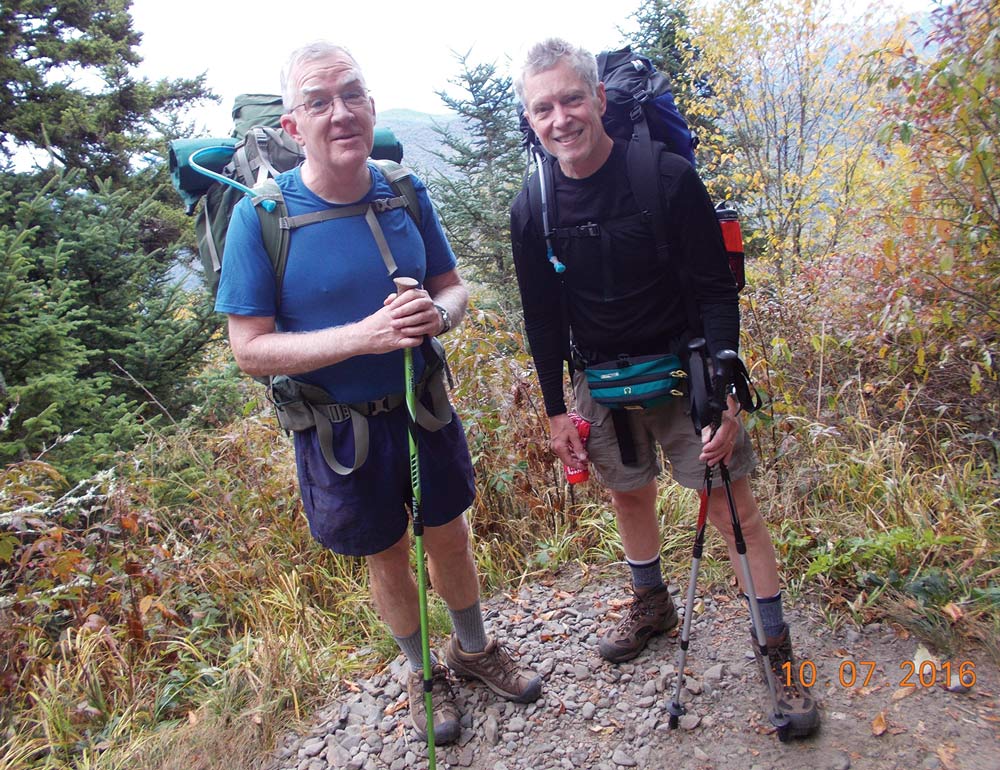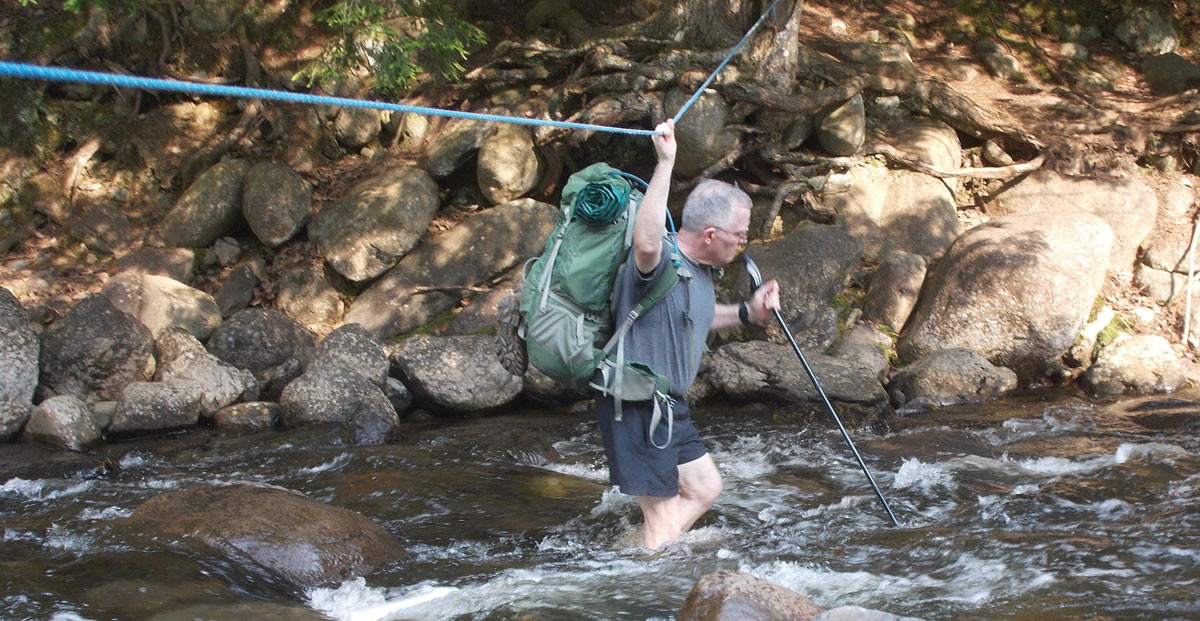That may sound absurd since I’ve backpacked over 1,000 miles of the Appalachian Trail. Certainly, there were many times along the A.T. when I reveled in having everything I needed in a pack on my back. But, for me, it also meant long, uncomfortable miles lugging a too-heavy pack, followed by a sleepless night crammed into a shelter.
Fortunately, I discovered that I could enjoy an easier way to tackle the Trail as a day hiker. I’d start at one trailhead with a small daypack, sustain a good pace, then leave the Trail for the comforts of an inn or motel, a hot shower, and a solid meal prepared by someone other than me. I’ve hiked over 1,100 miles of the A.T. as a day hiker.
My love affair with the A.T. began in 1970. As a fifteen-year-old Eagle Scout, I backpacked 300 miles of the Trail with a fellow Scout. We started in Maryland and passed through Pennsylvania, New Jersey, and New York. Our final destination had been Maine, but my buddy’s leg injury truncated our plans.
My wife and I raised four children in Frederick, Maryland, living within half an hour from the Trail. As my children grew up, we enjoyed short hikes together on the state’s nearly 41 miles of the A.T.
But backpacking? No thanks. I’d given that up after college — or so I thought.
In 2011, soon after I’d turned 56, a neighbor convinced me to take a couple of backpacking weekends in Shenandoah National Park. Those trips would set off a decade-long journey to hike the entire Trail.
My neighbor, Ted Gregory, was a committed backpacker and a good hiking companion. I became a reluctant backpacker, and we became official LASHers (long-a** section hikers). We started planning outings that jumped around the fourteen states that the A.T. passes through.
First, we completed a 75-mile section of the highlands of southwestern Virginia. Then we backpacked two sections of New York. We completed the 72 miles of Great Smoky Mountains National Park. We hiked the 100-Mile Wilderness in Maine and the final 15 miles to the Trail’s northern terminus at Mt. Katahdin. Hiking through New Hampshire’s White Mountains took a toll. As we aged well into our sixties, we spent three different summers just to navigate a 101-mile stretch.
I started to add some of our backpacking miles together with sections of the A.T. I completed only by day hiking. I also hopped around Tennessee, North Carolina, Connecticut, and Massachusetts. This added an extra 50 to 100 miles each year to my A.T. total. As my day hiking and backpacking miles grew, I realized I was in reach of completing the entire Trail.

Day hiking for me was much simpler and more enjoyable than backpacking. I could hike more miles comfortably. My hiking garb was usually just nylon shorts and a T-shirt. I hiked in Keene low-top hiking shoes and wool socks. My daypack contained a light rain jacket, some first aid essentials in a small plastic bag, toilet paper, and a sandwich and light snacks. I kept my cell phone off and took photos with a point-and-shoot camera. I sometimes used a single trekking pole like a staff. Even carrying abundant water, my daypack didn’t break 10 pounds.
The logistics of day hiking required careful planning. Trailheads and road crossings didn’t always line up neatly with the 12 to 18 miles I preferred to walk in a day. That meant an occasional 20-mile — or more — day. I also had to secure nightly lodging. I planned each day with an extra margin of safety to avoid an unexpected overnight on the Trail. After all, I was hiking for fun, not to worry!
Arranging to get to trailheads in the morning and get off the Trail again at night also took some doing. I used a variety of methods, including family members, hitchhiking, and paid shuttle drivers. Finding my starting points where the A.T. crossed local roads was often a challenge. My wonderful wife staged me for nearly all of Vermont. Two of my children spent a week with me while I finished up the southern end of the Trail in North Carolina and Georgia.
I also hitchhiked a fair amount. Along the A.T., hitchhiking is common as thru-hikers head to nearby towns in order to resupply. My trail name — “Hitchhiker” — was suggested by a hiking companion when I shared stories of my teenage cross-country hitchhiking exploits. I managed Shenandoah National Park’s 101 miles by parking along Skyline Drive, hitchhiking to my starting point, then hiking 15 to 18 miles back to my car. On another trip, I took an overnight train to South Carolina and hitchhiked 135 miles to North Carolina to begin a week’s worth of day hikes. Ted and I hitchhiked more than 50 miles together on two occasions after completing backpacking trips in Virginia and New Hampshire.
Still, the wilderness was always at hand. I’ve seen so much wildlife. I’ve fallen many times. I’ve scraped knees, turned ankles, got sunburned, and chafed. I’ve been very thirsty, hungry, tired, wet, and very muddy. I’ve been very cold, hot, and dirty. Being sweaty is an A.T. constant no matter the season or weather.
Yet hiking under forest canopies and through rhododendron thickets, viewing the vistas across open mountain balds, or climbing up and down rock-faced mountain paths was thrilling. At the end of each day, I was beat, but I felt gratified from walking my miles and experiencing another section of the Trail. Hiking the A.T. always made me feel alive.
However, while day hiking, I missed being able to chat with a companion. I’ve walked as long as six hours without seeing another hiker. One of the ways I occupied the long hours was to memorize and recite poetry aloud. My physical pacing seemed to help me memorize. I found the rhyme and meter of Longfellow and Robert Service to be particularly engaging. Edward Arlington Robinson, Tennyson, Yeats, Paul Laurence Dunbar, Frost, and Poe were some of the great poets that kept me company.

In 2021, I tackled the A.T. again. I hiked 43 miles in Vermont and 69 miles in western New Hampshire to finish those states. From Monson, Maine, I hiked 54 miles south. But with 99 miles to go, I faltered.
Ted came to Maine, and I slapped on a backpack for a notorious stretch of the Trail. With its mile-long obstacle course of enormous boulders, Mahoosuc Notch is said to be one of the hardest and slowest stretches of the entire Trail. I had a great time — even though I was backpacking.
When we drove back to Maryland, I still had 79 miles to go. I didn’t know whether I could stomach another trip to Maine. I’d hiked over 2,100 miles already. Did I really need to finish?
Thanks to Ted’s urging I undertook one last day-hiking trip to Maine in 2021. I quickly discovered I’d left perhaps the most challenging section of the entire Trail — based on the total elevation climbed and descended — for my final miles.
I had my car, but my insistence on day hiking required shuttle rides that took two hours and cost over $100. Several of the trailheads were down unmarked logging roads. Getting to one segment required a half-hour hike-in along an old forest road just to reach the A.T. Still, I considered it time and money well spent because I’d have never located the trailheads and A.T. crossings without the local shuttle drivers. As a result, I undertook seven terrific hikes, ate satisfying dinners, slept well at night, and made steady progress.
Finally, the last day arrived. On the morning of September 11, 2021, I started out with a Diet Coke in one hand, my hiking pole in the other, and two helium balloons tied to my daypack. Most hikers I crossed paths with were curious and offered congratulations. Atop Baldpate, four middle-aged hikers from Colorado spontaneously thrust their trekking poles into two overhead V’s for me to walk under when I told them it was my last day. I teared up as I pondered my looming accomplishment.
Two hours later, I popped out of the woods at Grafton Notch State Park. I was 66 years old, and had finally walked every mile of the Appalachian Trail. As I savored the day and thought of all the other outstanding days on the A.T., I understood why some thru-hikers end up hiking the Trail more than once.
I smile when I think of my eleven-year journey. I know I will be back on the A.T. again soon.